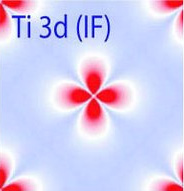Thursday, 22 April, 2010
Electron-hole systems at oxide interfaces
Key elements for tailored electronics
The interfaces of complex oxides can show unexpected characteristics distinct from the bulk materials. A targeted manipulation of these properties could yield electronics components with tailored functionalities. LMU materials scientist Dr. Rossitza Pentcheva and her team explored novel phenomena arising at the interface between the two insulators lanthanum aluminate (LaAlO3) and strontium titanate (SrTiO3). Recently, Mannhart and collaborators (U Augsburg) observed that beyond a critical thickness of the LaAlO3 layer the interface loses its insulating characteristics and becomes conductive. Within an international cooperation we were able to demonstrate that the effect can be manipulated by means of an additional SrTiO3 capping layer, says Pentcheva. Particularly fascinating is the formation of a bilayer consisting of mobile electrons at the interface and holes, the positively charged counter pieces of electrons, at the surface. Such excitonic or electron-hole systems only 1 to 2 nanometers apart could become key elements for novel electronics applications. (Physical Review Letters online, April 22, 2010) (...).
Complete press release (LMU)
Presseinformation der LMU
Publication "Parallel Electron-Hole Bilayer Conductivity from Electronic Interface Reconstruction"


